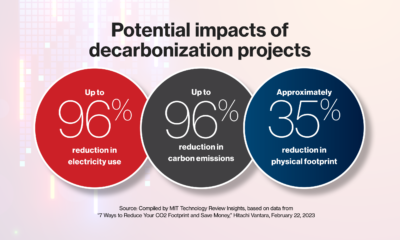Politics
Big Data Analytics: The Key to Resolving Complex Business Dilemmas
Published
12 months agoon
By
Drew Simpson
Big data analytics is the complex process of examining large and diverse datasets to uncover hidden patterns, correlations, market trends, and customer preferences. It is a crucial tool for organizations to make informed business decisions and tackle complex problems. In this article, we will explore the significance of big data analytics, its applications, benefits, challenges, and its history and growth.
The Importance of Big Data Analytics
Expertise Matters
Just as you would want a trained physician to diagnose your health problems, you need experts in big data analytics to help solve complex business problems. Subject Matter Experts (SMEs) or Known Opinion Leaders (KOLs) who have proven success in your industry can apply AI and analytics methods to develop a roadmap and lead your organization to success.
Advanced Analytics Techniques
Big data analytics is a form of advanced analytics, which involves complex applications with elements such as predictive models, statistical algorithms, and what-if analyses powered by analytics systems. It differs from traditional business intelligence (BI) queries, which answer basic questions about business operations and performance.
How Big Data Analytics Works
The big data analytics process consists of four main steps:
- Data Collection: Data analysts, data scientists, predictive modelers, statisticians, and other analytics professionals collect data from various sources, including semi-structured and unstructured data streams, such as internet clickstream data, web server logs, cloud applications, mobile applications, social media content, text from customer emails and survey responses, mobile phone records, and machine data from IoT sensors.
- Data Processing: After data is collected and stored in a data warehouse or data lake, data professionals must organize, configure, and partition the data properly for analytical queries. Thorough data preparation and processing lead to higher performance from analytical queries.
- Data Cleansing: Data professionals scrub the data using scripting tools or data quality software. They look for any errors or inconsistencies, such as duplications or formatting mistakes, and organize and tidy up the data.
- Data Analysis: The collected, processed, and cleaned data is analyzed with analytics software, which includes tools for data mining, predictive analytics, machine learning, deep learning, text mining, statistical analysis, artificial intelligence (AI), mainstream business intelligence software, and data visualization tools.
Key Big Data Analytics Technologies and Tools
Many different types of tools and technologies are used to support big data analytics processes. Some common technologies and tools include:
- Hadoop: An open-source framework for storing and processing big data sets, capable of handling large amounts of structured and unstructured data.
- Predictive Analytics: Hardware and software that process large amounts of complex data and use machine learning and statistical algorithms to make predictions.
- Stream Analytics: Tools used to filter, aggregate, and analyze big data stored in various formats or platforms.
- Distributed Storage: Data replicated on a non-relational database, providing protection against node failures and low-latency access.
- NoSQL Databases: Non-relational data management systems that work well with large sets of distributed data and do not require a fixed schema, making them ideal for raw and unstructured data.
- Data Lake: A large storage repository that holds native-format raw data until it is needed.
- Data Warehouse: A repository that stores large amounts of data collected by different sources, using predefined schemas.
- Knowledge Discovery/Big Data Mining: Tools that enable businesses to mine large amounts of structured and unstructured big data.
- In-Memory Data Fabric: Distributes large amounts of data across system memory resources, providing low data access and processing latency.
- Data Virtualization: Enables data access without technical restrictions.
- Data Integration Software: Streamlines big data across different platforms, including Apache, Hadoop, MongoDB, and Amazon EMR.
- Data Quality Software: Cleanses and enriches large data sets.
- Data Preprocessing Software: Prepares data for further analysis, including formatting and cleansing unstructured data.
- Spark: An open-source cluster computing framework used for batch and stream data processing.
Big data analytics applications often include data from both internal systems and external sources, such as weather data or demographic data on consumers compiled by third-party information service providers. Streaming analytics applications are also becoming common in big data environments, as users perform real-time analytics on data fed into Hadoop systems through stream processing engines like Spark, Flink, and Storm.
Big Data Analytics in Various Industries
Big data analytics has been embraced by a diverse range of industries as a key technology driving digital transformation. Users include retailers, financial services firms, insurers, healthcare organizations, manufacturers, energy companies, and other enterprises. Some examples of how big data analytics can be applied in these industries include:
- Customer Acquisition and Retention: Consumer data can help companies’ marketing efforts, acting on trends to increase customer satisfaction and create customer loyalty.
- Targeted Ads: Personalization data from sources such as past purchases, interaction patterns, and product page viewing histories can help generate compelling targeted ad campaigns.
- Product Development: Big data analytics can provide insights to inform product viability, development decisions, progress measurement, and steer improvements in the direction of what fits a business’s customers.
- Price Optimization: Retailers may opt for pricing models that use and model data from various sources to maximize revenues.
- Supply Chain and Channel Analytics: Predictive analytical models can help with preemptive replenishment, B2B supplier networks, inventory management, route optimizations, and the notification of potential delays to deliveries.
- Risk Management: Big data analytics can identify new risks from data patterns for effective risk management strategies.
- Improved Decision-Making: Insights extracted from relevant data can help organizations make quicker and better decisions.
Benefits of Big Data Analytics
The benefits of using big data analytics services include:
- Rapidly analyzing large amounts of data from different sources and formats.
- Making better-informed decisions for effective strategizing, which can benefit and improve the supply chain, operations, and other areas of strategic decision-making.
- Cost savings resulting from new business process efficiencies and optimizations.
- Better understanding of customer needs, behavior, and sentiment, leading to improved marketing insights and valuable information for product development.
- Improved and better-informed risk management strategies that draw from large sample sizes of data.
Challenges of Big Data Analytics
Despite the many benefits that come with using big data analytics, its use also presents challenges:
- Accessibility of Data: Storing and processing large amounts of data becomes more complicated as the volume of data increases. Big data should be stored and maintained properly to ensure it can be used by less experienced data scientists and analysts.
- Data Quality Maintenance: With high volumes of data coming from various sources and in different formats, data quality management for big data requires significant time, effort, and resources.
- Data Security: The complexity of big data systems presents unique security challenges. Addressing security concerns within such a complicated big data ecosystem can be complex.
- Choosing the Right Tools: Selecting from the vast array of big data analytics tools and platforms available on the market can be confusing, so organizations must know how to pick the best tool that aligns with users’ needs and infrastructure.
- Talent Gap: With a potential lack of internal analytics skills and the high cost of hiring experienced data scientists and engineers, some organizations are finding it difficult to fill the gaps.
History and Growth of Big Data Analytics
The term “big data” was first used to refer to increasing data volumes in the mid-1990s. In 2001, Doug Laney expanded the definition of big data by describing the increasing volume, variety, and velocity of generated and used data. These three factors became known as the 3Vs of big data. As per recent study most of the routine and daily based task will be automated in 2030.
The launch of the Hadoop distributed processing framework in 2006 was another significant development in the history of big data. Hadoop, an Apache open-source project, laid the foundation for a clustered platform built on top of commodity hardware that could run big data applications.
By 2011, big data analytics began to take a firm hold in organizations and the public eye, along with Hadoop and various related big data technologies. Initially, big data applications were primarily used by large internet and e-commerce companies such as Yahoo, Google, and Facebook, as well as analytics and marketing services providers. More recently, a broader variety of users have embraced big data analytics as a key technology driving digital transformation.
Conclusion
Big data analytics plays a crucial role in addressing complex business problems and helping organizations make informed decisions. Its applications, benefits, and growth have made it an indispensable tool in various industries. By understanding the challenges and choosing the right technologies and tools, organizations can harness the power of big data analytics to drive success and remain competitive in the marketplace.
Maneesh Singh
I am a captivating writer with a unique perspective and an unwavering passion for storytelling. With a talent for weaving words into rich tapestries of imagination, I brings a fresh and engaging voice to the literary world.
Drawing inspiration from a myriad of experiences, I crafts compelling narratives that resonate deeply with readers. Their ability to capture the essence of emotions and convey them through the written word is a testament to their innate gift for connecting with others.
My writing style is marked by a keen eye for detail, vivid descriptions, and a knack for creating well-rounded characters that readers can’t help but root for. They have an uncanny ability to transport readers to new worlds, immersing them in the sights, sounds, and emotions of each story they tell.
You may like
-


Make no mistake—AI is owned by Big Tech
-


The Download: Big Tech’s AI stranglehold, and gene-editing treatments
-


The first CRISPR cure might kickstart the next big patent battle
-


Sustainability starts with the data center
-


Meta is giving researchers more access to Facebook and Instagram data
-


The Biggest Questions: Why is the universe so complex and beautiful?
Politics
Fintech Kennek raises $12.5M seed round to digitize lending
Published
7 months agoon
10/11/2023By
Drew Simpson
London-based fintech startup Kennek has raised $12.5 million in seed funding to expand its lending operating system.
According to an Oct. 10 tech.eu report, the round was led by HV Capital and included participation from Dutch Founders Fund, AlbionVC, FFVC, Plug & Play Ventures, and Syndicate One. Kennek offers software-as-a-service tools to help non-bank lenders streamline their operations using open banking, open finance, and payments.
The platform aims to automate time-consuming manual tasks and consolidate fragmented data to simplify lending. Xavier De Pauw, founder of Kennek said:
“Until kennek, lenders had to devote countless hours to menial operational tasks and deal with jumbled and hard-coded data – which makes every other part of lending a headache. As former lenders ourselves, we lived and breathed these frustrations, and built kennek to make them a thing of the past.”
The company said the latest funding round was oversubscribed and closed quickly despite the challenging fundraising environment. The new capital will be used to expand Kennek’s engineering team and strengthen its market position in the UK while exploring expansion into other European markets. Barbod Namini, Partner at lead investor HV Capital, commented on the investment:
“Kennek has developed an ambitious and genuinely unique proposition which we think can be the foundation of the entire alternative lending space. […] It is a complicated market and a solution that brings together all information and stakeholders onto a single platform is highly compelling for both lenders & the ecosystem as a whole.”
The fintech lending space has grown rapidly in recent years, but many lenders still rely on legacy systems and manual processes that limit efficiency and scalability. Kennek aims to leverage open banking and data integration to provide lenders with a more streamlined, automated lending experience.
The seed funding will allow the London-based startup to continue developing its platform and expanding its team to meet demand from non-bank lenders looking to digitize operations. Kennek’s focus on the UK and Europe also comes amid rising adoption of open banking and open finance in the regions.
Featured Image Credit: Photo from Kennek.io; Thank you!
Radek Zielinski
Radek Zielinski is an experienced technology and financial journalist with a passion for cybersecurity and futurology.
Politics
Fortune 500’s race for generative AI breakthroughs
Published
7 months agoon
10/11/2023By
Drew Simpson
As excitement around generative AI grows, Fortune 500 companies, including Goldman Sachs, are carefully examining the possible applications of this technology. A recent survey of U.S. executives indicated that 60% believe generative AI will substantially impact their businesses in the long term. However, they anticipate a one to two-year timeframe before implementing their initial solutions. This optimism stems from the potential of generative AI to revolutionize various aspects of businesses, from enhancing customer experiences to optimizing internal processes. In the short term, companies will likely focus on pilot projects and experimentation, gradually integrating generative AI into their operations as they witness its positive influence on efficiency and profitability.
Goldman Sachs’ Cautious Approach to Implementing Generative AI
In a recent interview, Goldman Sachs CIO Marco Argenti revealed that the firm has not yet implemented any generative AI use cases. Instead, the company focuses on experimentation and setting high standards before adopting the technology. Argenti recognized the desire for outcomes in areas like developer and operational efficiency but emphasized ensuring precision before putting experimental AI use cases into production.
According to Argenti, striking the right balance between driving innovation and maintaining accuracy is crucial for successfully integrating generative AI within the firm. Goldman Sachs intends to continue exploring this emerging technology’s potential benefits and applications while diligently assessing risks to ensure it meets the company’s stringent quality standards.
One possible application for Goldman Sachs is in software development, where the company has observed a 20-40% productivity increase during its trials. The goal is for 1,000 developers to utilize generative AI tools by year’s end. However, Argenti emphasized that a well-defined expectation of return on investment is necessary before fully integrating generative AI into production.
To achieve this, the company plans to implement a systematic and strategic approach to adopting generative AI, ensuring that it complements and enhances the skills of its developers. Additionally, Goldman Sachs intends to evaluate the long-term impact of generative AI on their software development processes and the overall quality of the applications being developed.
Goldman Sachs’ approach to AI implementation goes beyond merely executing models. The firm has created a platform encompassing technical, legal, and compliance assessments to filter out improper content and keep track of all interactions. This comprehensive system ensures seamless integration of artificial intelligence in operations while adhering to regulatory standards and maintaining client confidentiality. Moreover, the platform continuously improves and adapts its algorithms, allowing Goldman Sachs to stay at the forefront of technology and offer its clients the most efficient and secure services.
Featured Image Credit: Photo by Google DeepMind; Pexels; Thank you!
Deanna Ritchie
Managing Editor at ReadWrite
Deanna is the Managing Editor at ReadWrite. Previously she worked as the Editor in Chief for Startup Grind and has over 20+ years of experience in content management and content development.
Politics
UK seizes web3 opportunity simplifying crypto regulations
Published
7 months agoon
10/10/2023By
Drew Simpson
As Web3 companies increasingly consider leaving the United States due to regulatory ambiguity, the United Kingdom must simplify its cryptocurrency regulations to attract these businesses. The conservative think tank Policy Exchange recently released a report detailing ten suggestions for improving Web3 regulation in the country. Among the recommendations are reducing liability for token holders in decentralized autonomous organizations (DAOs) and encouraging the Financial Conduct Authority (FCA) to adopt alternative Know Your Customer (KYC) methodologies, such as digital identities and blockchain analytics tools. These suggestions aim to position the UK as a hub for Web3 innovation and attract blockchain-based businesses looking for a more conducive regulatory environment.
Streamlining Cryptocurrency Regulations for Innovation
To make it easier for emerging Web3 companies to navigate existing legal frameworks and contribute to the UK’s digital economy growth, the government must streamline cryptocurrency regulations and adopt forward-looking approaches. By making the regulatory landscape clear and straightforward, the UK can create an environment that fosters innovation, growth, and competitiveness in the global fintech industry.
The Policy Exchange report also recommends not weakening self-hosted wallets or treating proof-of-stake (PoS) services as financial services. This approach aims to protect the fundamental principles of decentralization and user autonomy while strongly emphasizing security and regulatory compliance. By doing so, the UK can nurture an environment that encourages innovation and the continued growth of blockchain technology.
Despite recent strict measures by UK authorities, such as His Majesty’s Treasury and the FCA, toward the digital assets sector, the proposed changes in the Policy Exchange report strive to make the UK a more attractive location for Web3 enterprises. By adopting these suggestions, the UK can demonstrate its commitment to fostering innovation in the rapidly evolving blockchain and cryptocurrency industries while ensuring a robust and transparent regulatory environment.
The ongoing uncertainty surrounding cryptocurrency regulations in various countries has prompted Web3 companies to explore alternative jurisdictions with more precise legal frameworks. As the United States grapples with regulatory ambiguity, the United Kingdom can position itself as a hub for Web3 innovation by simplifying and streamlining its cryptocurrency regulations.
Featured Image Credit: Photo by Jonathan Borba; Pexels; Thank you!
Deanna Ritchie
Managing Editor at ReadWrite
Deanna is the Managing Editor at ReadWrite. Previously she worked as the Editor in Chief for Startup Grind and has over 20+ years of experience in content management and content development.
